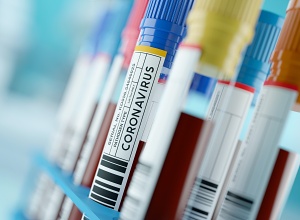86% of people who tested positive for COVID-19 during lockdown did not have virus symptoms (cough, and/or fever, and/or loss of taste/smell), finds a study by University College London researchers. The authors say a more widespread testing programme is needed to catch ‘silent’ transmission.
The study used data from the Office for National Statistics Coronavirus (COVID-19) Infection Survey pilot study – a large population-based survey looking at the association between COVID-19 symptoms and COVID-19 test results.
The study included data from a representative population sample of 36,061 people living in England, Wales and Northern Ireland who were tested between 26 April and the 27 June 2020 and provided information of whether they had any symptoms.
The data showed 115 (0.32%) people out of the total 36,061 people in the pilot study had a positive test result. Focusing on those with COVID-19 specific symptoms (cough, and/or fever, and/or loss of taste/smell), there were 158 (0.43%) with such symptoms on the day of the test.
Of the 115 with a positive result, there were 16 (13.9%) reporting symptoms and in contrast, 99 (86.1%) did not report any specific symptoms on the day of the test.
The study also includes data on people reporting a wider range of symptoms such as fatigue and shortness of breath. Of the sample who tested positive, 27 (23.5%) were symptomatic and 88 (76.5%) were asymptomatic on the day of the test.
The authors say the findings have significant implications for ongoing and future testing programmes.
Professor Irene Petersen (UCL Epidemiology & Health Care) explained: “The fact that so many people who tested positive were asymptomatic on the day of a positive test result calls for a change to future testing strategies. More widespread testing will help to capture “silent” transmission and potentially prevent future outbreaks.
“Future testing programmes should involve frequent testing of a wider group of individuals, not just symptomatic cases, especially in high-risk settings or places where many people work or live close together such as meat factories or university halls. In the case of university halls, it may be particularly relevant to test all students before they go home for Christmas.
“Pooled testing could be one way to help implement a widespread testing strategy where several tests are pooled together in one analysis to save time and resources on individual testing. This strategy would be an efficient way to test when the overall prevalence is low as negative pooled samples can quickly show a large group of people are not infectious.”
The authors did note that several studies have highlighted a lower proportion of individuals testing positive for COVID-19 are asymptomatic, however, the prevalence of asymptomatic cases varies substantially, possibly due to the sampling and the settings of the study. For example, the study references how among 262 confirmed cases admitted to hospitals in Beijing 13 (5%) were asymptomatic. In contrast, reports from a small village in Italy suggest that up to 40–75% were asymptomatic. A study of 13,000 residents in Iceland found 43 out of 100 with a positive COVID-19 test were asymptomatic.
Co-author Professor Andrew Phillips (UCL Institute of Global Health) added: “When considering SARS Cov 2 testing it is important to consider the purpose of the test. A test done to indicate whether a person currently has virus levels that are likely to mean they are infectious, and not to rule in or rule out any presence of virus, does not require such a high sensitivity and cheaper rapid tests are more feasible. “
Abstract
Background: To reduce transmission of SARS-CoV-2, it is important to identify those who are infectious. However, little is known about what proportion of infectious people are asymptomatic and potential “silent” transmitters. We evaluated the value of COVID-19 symptoms as a marker for SARS-CoV-2 infection from a representative English survey.
Methods: We used data from the Office for National Statistics Coronavirus (COVID-19) Infection Survey pilot study. We estimated sensitivity, specificity, the proportion of asymptomatic cases (1 – sensitivity), positive predictive value (PPV) and negative predictive value (NPV) of COVID-19 symptoms as a marker of infection using results of the SARS-CoV-2 test as the “gold standard”.
Results: In total, there were 36,061 individuals with a SARS-CoV-2 test between 26 April and 27 June 2020. Of these, 625 (1.7%) reported symptoms on the day of the test. There were 115 (0.32%) with a positive SARS-CoV-2 test result. Of the 115, there were 27 (23.5%) who were symptomatic and 88 (76.5%) who were asymptomatic on the day of the test. Focusing on those with specific symptoms (cough, and/or fever, and/or loss of taste/smell), there were 158 (0.43%) with such symptoms on the day of the test. Of the 115 with a positive SARS-CoV-2, there were 16 (13.9%) reporting symptoms. In contrast, 99 (86.1%) did not report specific symptoms on the day of the test. The PPV for all symptoms was 4.3% and for the specific symptoms 10.1%. The specificity and NPV of symptoms were above 98%.
Conclusion: COVID-19 symptoms are poor markers of SARS-CoV-2. Thus, 76.5% of this random sample who tested positive reported no symptoms, and 86.1% reported none of those specific to COVID-19. A more widespread testing programme is necessary to capture “silent” transmission and potentially prevent and reduce future outbreaks.
Authors
Irene Petersen, Andrew Phillips
[link url="https://www.ucl.ac.uk/news/2020/oct/symptoms-covid-19-are-poor-marker-infection"]University College London material[/link]
[link url="https://www.dovepress.com/three-quarters-of-people-with-sars-cov-2-infection-are-asymptomatic-an-peer-reviewed-article-CLEP"]Clinical Epidemiology abstract[/link]

